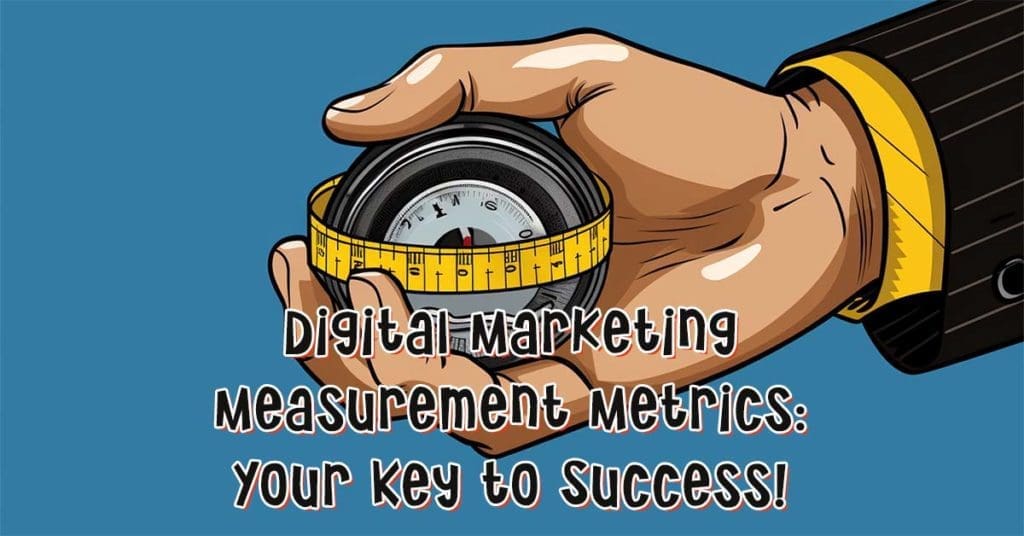Digital Marketing Measurement Metrics: Your Key to Success!
Key Takeaways:
- The Importance of Digital Marketing Measurement: Proper measurement and analysis of digital marketing efforts is crucial for determining the success or failure of a strategy. Without accurate measurement, making informed decisions and optimizing campaigns is difficult.
- The Misconception of Digital Campaign Value: Many marketers mistakenly focus solely on metrics such as clicks and impressions without considering the actual impact on their business goals. It is important to align digital campaigns with specific objectives and measure the value they bring in terms of conversions, ROI, and overall business growth.
- The True Value of Digital Channels: Digital marketing channels offer unique advantages such as precise targeting, cost-effectiveness, and tracking and optimizing campaigns in real-time. Understanding the value and potential of digital channels can help marketers create more effective strategies.
- The Need for Cross-Channel Measurement: Digital marketing is a complex ecosystem with multiple channels and touchpoints. Measuring the performance of individual channels and understanding how they work together is essential for optimizing the overall marketing strategy and maximizing results.

The Importance of Digital Marketing Measurement
Digital marketing’s crucial aspect is measuring its effectiveness, an essential determinant for success. Accurate measurement helps businesses evaluate their strategies, identify areas of improvement, and optimize resources for better returns. By understanding the impact of their digital marketing efforts, organizations can make informed decisions, allocate budgets wisely, and achieve targeted results.
Additionally, measurement allows for tracking ROI and analyzing customer engagement, enabling businesses to refine their marketing strategies based on real data-driven insights. Investing in digital marketing measurement is imperative for companies aiming to stay competitive in the ever-evolving digital landscape.
The Misconception of Digital Campaign Value

Many marketers rely solely on surface-level metrics.
The understanding of the value of digital campaigns is often misconstrued, leading to failed strategies and wasted resources. This article aims to shed light on the common misconceptions surrounding the effectiveness of digital campaigns.
- Inaccurate Metrics: Many marketers rely solely on surface-level metrics such as clicks and impressions to assess the success of their digital campaigns. However, these metrics do not comprehensively represent the true value and impact generated.
- Lack of Attribution: Another misconception is the failure to properly attribute the results of a digital campaign. Often, credit is given solely to the last click or interaction, ignoring the multiple touchpoints and channels that contribute to a conversion.
- Overemphasis on Immediate Results: Many marketers expect immediate and direct results from their digital campaigns, overlooking the fact that the impact of such campaigns can take time to manifest. This misconception can lead to premature abandonment of effective strategies.
- Neglecting Brand Awareness: Some marketers underestimate the importance of brand awareness in digital campaigns, focusing solely on driving immediate sales. Building brand recognition and fostering customer trust are vital components of a successful digital strategy.
Additionally, understanding the nuances of different target audiences and tailoring campaigns accordingly is crucial for achieving optimal results. By recognizing and debunking the misconceptions surrounding the value of digital campaigns, marketers can adapt their strategies to maximize effectiveness.
A true fact: According to a study by Zenith Media, digital ad spending is projected to reach $517.5 billion worldwide by 2023.
The True Value of Digital Channels
Digital Channels: Unleashing the Full Potential
Digital channels have proven themselves to be indispensable in today’s marketing landscape. They offer a myriad of opportunities for businesses to connect with their target audience, expand their reach, and drive meaningful engagement. The true value of digital channels lies in their ability to deliver targeted messages, measure performance in real-time, and foster personalized interactions. By leveraging these channels effectively, businesses can gain a competitive edge, build brand loyalty, and achieve their marketing objectives.
To fully grasp the true value of digital channels, it is crucial to understand their unique advantages. Unlike traditional marketing methods, digital channels allow for precise audience targeting, ensuring that messages reach the right people at the right time. Through data-driven insights and sophisticated analytics, businesses can optimize their campaigns, refine their strategies, and continuously improve their marketing efforts. This precision and flexibility set digital channels apart, enabling businesses to maximize their return on investment.
Moreover, digital channels empower businesses to engage with their audience on a personal level. By leveraging various platforms such as social media, websites, and email marketing, businesses can create tailored experiences for their customers. Businesses can establish meaningful connections through personalized content and targeted messaging, foster brand loyalty, and drive customer retention. The ability to provide relevant and timely information creates a unique value proposition for businesses, setting them apart from their competitors.
Pro Tip: To fully realize the true value of digital channels, it is essential to adopt a data-driven approach. By continuously monitoring and analyzing key performance indicators, businesses can identify areas of improvement, optimize their strategies, and stay ahead of the curve. Remember, the true value of digital channels lies in their ability to deliver personalized experiences, engage with the audience, and achieve marketing objectives efficiently.
The Need for Cross-Channel Measurement

It is essential to implement a robust cross-channel measurement strategy.
The importance of measuring performance across multiple marketing channels is crucial to digital marketing success. By evaluating the effectiveness of different channels, businesses can optimize their strategies and allocate resources more effectively. This process allows for a comprehensive understanding of customer behavior and enables businesses to make informed decisions when developing marketing campaigns. By adopting a cross-channel measurement approach, businesses can maximize their marketing efforts and ultimately drive better results.
In order to achieve the desired outcomes, it is essential to implement a robust cross-channel measurement strategy. This involves collecting and analyzing data from various sources to gain insights into customer engagement and conversion rates. By examining the performance of different channels, businesses can identify which ones are most effective in achieving their objectives. This allows for the allocation of resources to be adjusted accordingly, ensuring maximum impact and ROI.
In addition to evaluating the effectiveness of each channel, cross-channel measurement also provides valuable insights into the customer journey. By tracking customer interactions across multiple touchpoints, businesses can identify patterns and trends in customer behavior. This knowledge can then be used to optimize marketing strategies and tailor experiences to customers’ individual preferences. Understanding the customer journey is crucial for creating personalized and targeted marketing efforts that resonate with consumers and drive conversions.
One example of the power of cross-channel measurement is a fashion retailer struggling to understand the impact of its marketing efforts across different channels. By implementing a cross-channel measurement strategy, they were able to gather data from their website, social media platforms, and email campaigns. Analyzing this data revealed that their email campaigns effectively drove website traffic and conversions. Armed with this knowledge, they were able to reallocate resources to focus more on email marketing, resulting in increased revenue and customer engagement.
Some Facts About Digital Marketing Measurement:
- ✅ Many retailers focus only on eCommerce sales impacts of their digital marketing, ignoring the in-store sales impacts because it’s “difficult to measure.” (Source: Team Research)
- ✅ Web analytics tools and measurements provided by large platforms like Google and Meta rely on clicks to measure campaign value. (Source: Team Research)
- ✅ Privacy changes made by Apple and soon by Google are making it harder to track individual consumers and measure digital ads’ impact on e-commerce. (Source: Team Research)
- ✅ Roughly two-thirds of leading digital channels’ impacts are on in-store sales, with only about 30% of the return found in e-commerce sales. (Source: Team Research)
- ✅ Traditional media channels like direct mail and linear TV also drive most of their impact and value in physical store sales. (Source: Team Research)
FAQs About Digital Marketing Measurement

FAQs About Digital Marketing Measurement
1. Why are many retailers still only focusing on the e-commerce sales impacts of their digital marketing?
Many retailers still only focus on the e-commerce sales impacts of their digital marketing because they find it difficult to measure the in-store sales impacts.
2. How has the measurement of digital ads’ impact on e-commerce become more challenging?
The measurement of digital ads’ impact on e-commerce has become more challenging due to major privacy changes made by Apple and upcoming changes from Google that restrict tracking individual consumers.
3. What does a retail marketing impact benchmark reveal about the importance of digital measurement?
A retail marketing impact benchmark reveals that approximately two-thirds of leading digital channels’ impacts are on in-store sales, emphasizing the significance of measuring digital marketing correctly.
4. What percentage of the value of paid search campaigns comes from e-commerce sales?
Approximately 36 percent of the value of paid search campaigns comes from e-commerce sales, with the remaining 64 percent of the campaigns’ impacts driven by brick-and-mortar sales.
5. How do traditional media channels, such as direct mail and linear TV, contribute to sales impacts?
Traditional media channels, such as direct mail and linear TV, drive most of their impact and value in physical store sales, with approximately a 20 percent e-commerce and 80 percent in-store sales impact ratio.
6. Why is it important for marketing measurement to break out of the “digital-only” silo?
It is important for marketing measurement to break out of the “digital-only” silo because consumers don’t consume media or behave in channels. Retail marketers need to educate and engage consumers wherever they are and meet their preferences accordingly in order to survive and thrive in the evolving retail landscape.

